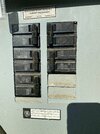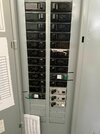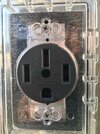When plugging and unplugging the EVSE it is safest to first turn off the power to the receptacle at the service panel. (It states this in the installation guide of both EVSEs fitted with a NEMA 14-50 power plug that I have owned.) There is a risk of getting shocked while plugging and unplugging the EVSE. That is why the latest version of the NEC dated 2017 specifies GFCI protection for a 14-50 receptacle used for charging an EV. Note: The EVSE already has a built in GCFI to protect the user when plugging in the charging cord. Not all locations, jurisdictions have yet adopted the 2017 version of the NEC.I've been charging my RAV4EV, my Model Ses and a 3 now for almost ten years, always on a 14-50 outlet, NEVER with a GFCI breaker. Not because it costs $100, but because I felt it was unnecessary. As my garage is dry all the time, I don't see the need. I use the supplied charge cable, and when going on vacation I unplug it. NEVER have I felt that my unplugging caused excessive wear on the outlet or the plug, and never have I found any cable warmth when charging. I did wire using 6-3 w/ground, but I also doubt that I used any specialty outlet. For such little use, I can't see the reasoning, other than some people just need to feel they've done all they can, beyond any basis in reality.
I suspect Plan C would do the job just as well as Plan B.
Welcome to Tesla Motors Club
Discuss Tesla's Model S, Model 3, Model X, Model Y, Cybertruck, Roadster and More.
Register
Install the app
How to install the app on iOS
You can install our site as a web app on your iOS device by utilizing the Add to Home Screen feature in Safari. Please see this thread for more details on this.
Note: This feature may not be available in some browsers.
-
Want to remove ads? Register an account and login to see fewer ads, and become a Supporting Member to remove almost all ads.
You are using an out of date browser. It may not display this or other websites correctly.
You should upgrade or use an alternative browser.
You should upgrade or use an alternative browser.
Wall Connector vs 14-50R Outlet Plus Mobile Connector
- Thread starter rjpjnk
- Start date
GtiMart
Active Member
I saw things like this article: The Best Home EV Charger Buying Guide For 2020Right -- idea is to plug the EVSE into it, as is required by vehicle design in all cases. Who makes a 120v-only BEV?
Quote: "However, most manufacturers only provide a basic level 1, 120-volt charger, and offer a higher-powered level 2 unit for sale as an option."
I believe my friend's Hyundai Ioniq (1st gen) is only 120V on the provided mobile charger. His car obviously supports J1772...
That was true in the past but other EV manufacturers now offer dual mode 120V/240V EVSE as standard or as an option with the purchase of the EV. GM is the latest to offer a 240V EVSE with the 2022 Bolt and 2022 Bolt EUV (although the 2022 Bolt/Bolt EUV have started shipping to dealers this new dual voltage EVSE has not yet been delivered.) Not sure about Ford.I saw things like this article: The Best Home EV Charger Buying Guide For 2020
Quote: "However, most manufacturers only provide a basic level 1, 120-volt charger, and offer a higher-powered level 2 unit for sale as an option."
I believe my friend's Hyundai Ioniq (1st gen) is only 120V on the provided mobile charger. His car obviously supports J1772...
Wolfpacker83
Member
I actually have two panels. The first panel in the pictures below is on the side of my home by the meter. It has the range, AC, hot water heater, etc... and it looks like it has a 100A breaker that feeds the sub panel.Outlets that overheat are either old and worn out causing the plug to not make a tight connection or else improperly wired. (For a standard 120V/15A receptacle always use the screw down terminals and not the push in connections on the back of the receptacle.) A NEMA 14-50R is rated for 50A so everything including the wire is designed for a up to 50A load. Don't use a cheap NEMA 14-50 receptacle. The recommended manufacturers are Hubbell, Bryant and Cooper. Even though the circuit and the receptacle is rated for 50A when charging an EV the rule is 80% of the rated load, so 40A. Even then, the Tesla Mobile Connector that comes with the Tesla vehicle is capable of a maximum of 32A when used with the NEMA 14-50 plug adapter.
Be aware that if you install the receptacle at the back of the garage the charging cord of the Tesla Mobile Connector and also the Tesla Wall Connector is only 18.5 feet long and may not reach the charging port located on the left rear quarter panel of the Tesla vehicle by the tail light. A better location for the receptacle would be on the side wall of the garage on the side where you plan to park the Tesla and charge, closer to the garage door so the charging cord can reach the charging port.
The sub panel is in the second picture below and is located in my garage. Which panel would I be able to connect the 14-50 to? Would I have to connect it to the main one by the meter or could I connect it to the sub panel?
Attachments
Your electrician would be able to perform a load calculation, also determine if you can add a 240V - 40A or 50A circuit to your existing service. (I stated 40A or 50A because you can use the NEMA 14-50 receptacle with a 40A breaker if there is not enough capacity for adding a 50A circuit.)I actually have two panels. The first panel in the pictures below is on the side of my home by the meter. It has the range, AC, hot water heater, etc... and it looks like it has a 100A breaker that feeds the sub panel.
The sub panel is in the second picture below and is located in my garage. Which panel would I be able to connect the 14-50 to? Would I have to connect it to the main one by the meter or could I connect it to the sub panel?
If the electrician determines that you can't add 50A or 40A you may be able to add a 30A (commonly used with electric clothes dryers) or even a 240V/20A. In most cases any of 20A/30A/40A/50A would be adequate for daily charging at home. (The vehicle does not perform any differently, only the time to charge varies. In most cases charging can be scheduled to start and complete while you are asleep.) The 40A/50A can be used with the NEMA 14-50 receptacle. The 30A can be used with the NEMA 14-30 receptacle and the 20A can be used with use the NEMA 6-20 receptacle. Tesla sells plug adapters for the Gen2 Mobile Connector for all of these receptacles on the Tesla store. Gen 2 NEMA Adapters
Last edited:
Wolfpacker83
Member
My range is connected to a 40A breaker and my dryer is connected to 30A breaker. The dryer uses a smaller circuit than the range, correct?Your electrician would be able to perform a load calculation, also determine if you can add a 240V - 40A or 50A circuit to your existing service. (I stated 40A or 50A because you can use the NEMA 14-50 receptacle with a 40A breaker if there is not enough capacity for adding a 50A circuit.)
If the electrician determines that you can't add 50A or 40A you may be able to add a 30A (commonly used with electric clothes dryers) or even a 240V/20A. In most cases any of 20A/30A/40A/50A would be adequate for daily charging at home. The 40A/50A can be used with the NEMA 14-50 receptacle. The 30A can be used with the NEMA 14-30 receptacle and the 20A can be used with use the NEMA 6-20 receptacle.
The maximum circuit rating is rated based on the circuit breaker, wire gauge and the receptacle (if the equipment is hard wired as with an A/C compressor or a water heater then there is no receptacle.) A 40A circuit is sized for higher amperage ((240V, 40 amps) than a circuit that is protected by a 30A circuit breaker. The maximum power available from a circuit rated for 40A is 33% more than for a circuit rated for 30A. So the 30A dryer circuit is smaller (less power, less amperage) than the 40A range circuit.My range is connected to a 40A breaker and my dryer is connected to 30A breaker. The dryer uses a smaller circuit than the range, correct?
(Note for EV charging you take the maximum amperage rating of the circuit and reduce this to 80% of the circuit rating so all of these circuits operate at no more than 80% of their rated capacity when used for charging an EV or any vehicle with a plug.)
Last edited:
Wolfpacker83
Member
Thanks again for your expertise. After looking at this page, Gen 2 NEMA Adapters, it looks like I would be fine with a 14-30 outlet or even a 6-20. I will get estimates from some local electricians to get their thoughts. Thanks,.The maximum circuit rating is rated based on the circuit breaker, wire gauge and the receptacle (if the equipment is hard wired as with an A/C compressor or a water heater then there is no receptacle.) A 40A circuit is sized for higher amperage ((240V, 40 amps) than a circuit that is protected by a 30A circuit breaker. The maximum power available from a circuit rated for 40A is 33% more than for a circuit rated for 30A. So the 30A dryer circuit is smaller (less power, less amperage) than the 40A range circuit.
(Note for EV charging you take the maximum amperage rating of the circuit and reduce this to 80% of the circuit rating so all of these circuits operate at no more than 80% of their rated capacity when used for charging an EV or any vehicle with a plug.)
lax20attack
New Member
Thanks for the response.You can add or replace a plug on a piece of equipment and most of the time time nothing bad will happen.
Sorry, I don't have a link. Perhaps someone has the specific section of the NEC that prohibits adding a power plug to equipment that is designed by the manufacturer to be hard wired. (I believe it was Rocky_H who provided this information in a different thread.)
As far as a thermal sensor, check with any EVSE manufacturer, i.e. ClipperCreek. If the EVSE has a power plug there is a thermal sensor molded into the plug head. The sensor is wired to the EVSE controller board. The EVSE will stop charging if the plug gets too warm before the insulation in the plug starts to melt. Plugs can get dangerously warm due to a loose fit with the receptacle, dirt and corrosion (this is not an issue with a hard wired connection.)
Tesla used to make a version of the Wall Connector with a 14-50 plug. Discussion here: What happened to the Tesla Wall Connector with the NEMA 14-50 plug?
Point taken about potential loose connections if unplugging. I suppose this applies to any outlet installed in any house really. In my case I installed a lock box around the receptacle and plugged in wall connector.
The issue with the receptacle not being designed for a high number of plug and unplug operations is specific to the 240V receptacles such as the NEMA 14-50, 14-30. In a home these are typically specified for electric wall ovens, electric ranges and electric dryers. These appliances are hardly ever unplugged unless needing to be repaired or replaced. A standard NEMA 5-15 receptacle can be used many thousands of times without issue (although in a garage or outdoor environment moisture and corrosion can affect the life of the receptacle) so if more than 5 years old it is an inexpensive precaution to replace the receptacle you plan to use for charging at 120V.Point taken about potential loose connections if unplugging. I suppose this applies to any outlet installed in any house really.
beenmb
Member
A restaurant in my area just installed a 14-50R outlet. Is the R of the 14-50R a no go for my Tesla Model 3 14-50 adaptor that came with the car? Also, see the photo attached is the outlet installed up side down? Cable would go up not hang down possibly damaging the plastic outlet cover that opens up. Might add there are a lot of RVs in this area. Anyway got excited for we live in a condo, home charging not an option, Supercharger a pretty good distance away. Thanks so much. Very appreciated.
Attachments
It's much more simple than that, but if you haven't seen the terminology, you just wouldn't know yet. A 14-50R isn't different from a 14-50.A restaurant in my area just installed a 14-50R outlet. Is the R of the 14-50R a no go for my Tesla Model 3 14-50 adaptor that came with the car?
If you are buying individual hardware parts, they will refer to the pieces as either 14-50R (receptacle) or 14-50P (plug). So that's just referring to which side it is. Is it the receptacle in the wall, or the plug with the pins sticking out?
That is different than if you see the letter L at the front, like an L14-50. That L stands for "locking". Those are ones where you plug it in, and then twist it to lock the connection together, so the pins are shaped differently and are in kind of a ring shape so it can be rotated while it is plugged in.
Well yeah, that's kind of annoying. The Tesla plugs are made with that round ground pin at the top, so yes, you're right that the plug would be going upward. Whether that is a problem just depends on physically if there is enough space for the cord, and if you can hang it or support it on something so it doesn't have all of that weight pulling back down on the plug.Also, see the photo attached is the outlet installed up side down? Cable would go up not hang down possibly damaging the plastic outlet cover that opens up.
Similar threads
- Replies
- 9
- Views
- 408
- Replies
- 5
- Views
- 555
- Replies
- 64
- Views
- 12K





